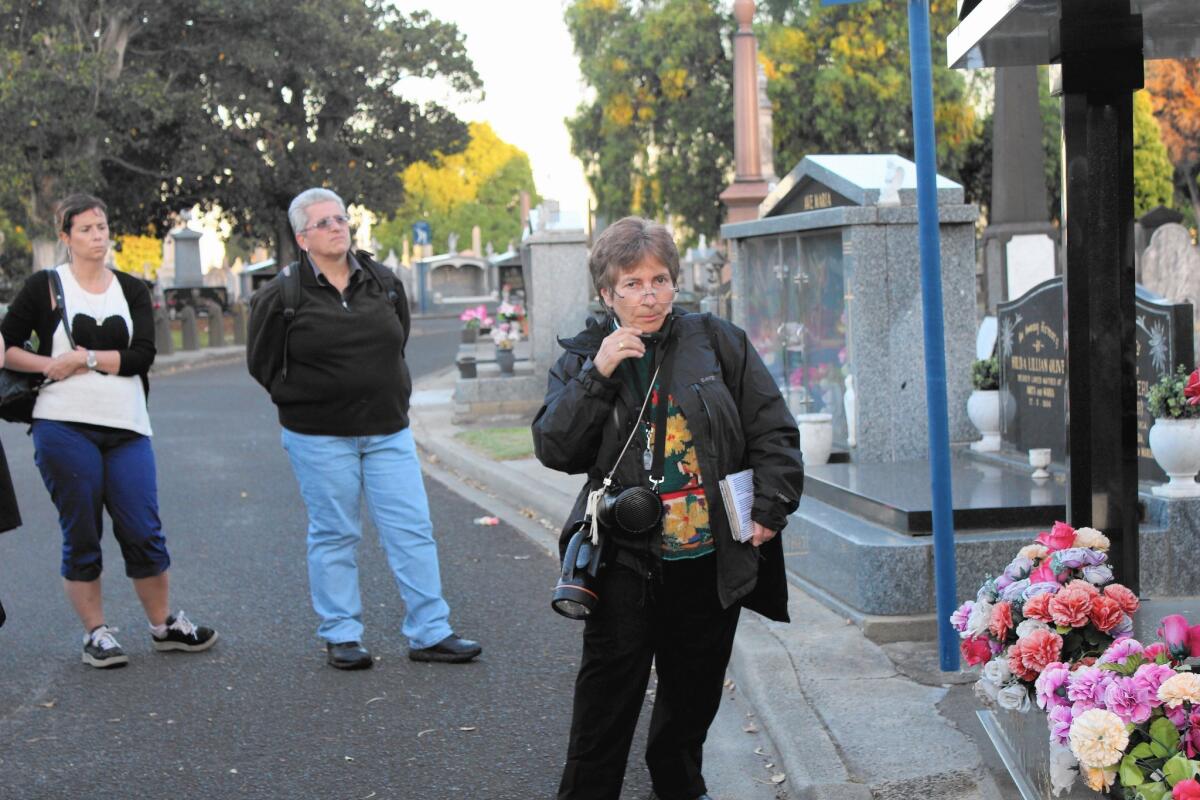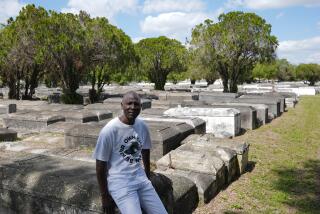Melbourne cemetery reinvents itself as tourist spot

It’s twilight in the graveyard. Large bats circle lazily overhead.
In the gloom, folks gather around the tomb of actor Frederick Baker, whose ghost (legend has it) haunts a theater not far from where his remains lie. The last rays of light disappear behind the headstones, as the visitors recall his final moments.
Baker, known as Federici, died while playing the Devil.
The people here are not mourners, ghost hunters, vandals or fans of Baker. Rather, they’re tourists, participating in one of the Melbourne General Cemetery’s popular night tours.
There’s a spine-tingling sense of daring walking in a graveyard at night, even in the herd safety of a tour group with flashlights. In the velvety darkness, death’s mystery seems to brush against them.
The spicy scent of a peppercorn tree wafts through the still night air, as multiple feet crunch across the fallen peppercorn sprigs. (Such trees were traditionally planted in graveyards as a sign of religious fervor.) Pencil pines are also among the monuments, a soaring tree favored in the belief they elevated the souls of the dead to heaven.
“If you ask people what is the most frightening thing to do, they say, ‘Walking in a cemetery at night.’ There’s a real mystique about it,” says Melbourne’s cemeteries trust historical and cultural director, Celestina Sagazio, explaining the tours’ popularity. “I think it’s that fascination with the spirit world, the fear of death, and confronting that fear. It’s that courage aspect: You’ve got the courage to do it.”
As the historic grounds host fewer funerals and some graves fall into decay, the Melbourne General Cemetery is reinventing itself as tourist spot and picnic park. The most popular night tour is on Halloween, when visitors in ghoulish costumes troop between the graves. But the Friday the 13th, Midsummer and Full Moon tours always sell out, often turning dozens away.
Sagazio, who believes graveyards are for the living as much as the dead, recently announced plans to cater for a range of social functions, including pre-death wakes (for people who want to be at their own wakes), philosophical lectures and weddings (a sure way to reinforce the message, “ ‘Til death do us part”).
That said, the night tours began several years back “almost as a bit of a dare,” Sagazio says. Someone suggested the idea, half joking, but Sagazio decided to give it a try. “Some people thought it was unusual, even ghoulish. But it’s got to be respectful.” The tours took off.
“It’s demystifying death, because we have this great fear of death and cemeteries. By visiting them, our fear diminishes. Exposure decreases fear,” says Sagazio during an interview at one of the trust’s newer cemeteries, Springvale Botanical, which has a restaurant with a French chef, regular jazz bands, theater and children’s playgrounds.
With fear and taboo surrounding death, cemetery management the world over faces a problem: how to maintain historically important monuments when no one wants to walk through the front gate.
“We are trying to come up with a tourism strategy, because it [the Melbourne General Cemetery] is coming to the end of its natural life,” Sagazio says. “We think we are ready for some of these more adventurous cultural activities, but respectful.
“Some people want a spooky experience, let’s be honest about that, but a lot of people are interested in the history.”
A consummate tour guide, she spices the night tours with quirky historical facts, tidbits about grave monuments, hints of scandal and juicy stories of the departed (and at least five jokes). But there also are poignant moments, stories of long-forgotten city heroes who perished tragically or beloved stars who died too young.
“By making people come back to cemeteries, you’re encouraging more respect, visiting the deceased,” Sagazio says. “We should value cemeteries. They’re not morbid places. They’re literally places to celebrate life, when you have got people in there appreciating these fabulous stories.”
The graveyard has a scandalous history; it was once infiltrated by an organized crime syndicate that sold off plots multiple times and even stole flowers left on people’s graves for resale.
In the darkness, tourists take in a broken pillar, symbolizing a life cut short, on the grave of Florence Young, a popular 19th century songstress. They also recall the tragedy of a young woman whose tombstone warns against marrying in haste after she was killed by her new husband and hidden under the hearth in her home. There’s a grave of a famous American wrestler, Clarence Whistler, known as the “Kansas Cyclone” who died at 29 in 1885 after falling into a coma after a three-week drinking binge during a tour to Melbourne. (His party trick, chewing up champagne glasses, probably didn’t help.)
As the night’s darkness deepens, sadness seeps in, passing the blank grassy knoll where paupers are buried without headstones. Nobody looks at the grave of young jockey Ray Wilson, who died during a race at 28, without a sigh. His tombstone bears a saddle carved in stone. And there’s the tragic tale of Christopher Gee, a firefighter who fell into the flames on a ship at a nearby port. His story would have been long forgotten, if not for his tombstone, with its carvings of a burning ship, fireman’s helmet and fire hose.
By his grave, visitors flinch at a blood-curdling growl, coming out of the gloom. But it’s just a possum, Sagazio reassures them, a fluffy creature with large eyes and fearsome claws that thrives in Melbourne’s gardens.
More to Read
Start your day right
Sign up for Essential California for news, features and recommendations from the L.A. Times and beyond in your inbox six days a week.
You may occasionally receive promotional content from the Los Angeles Times.






